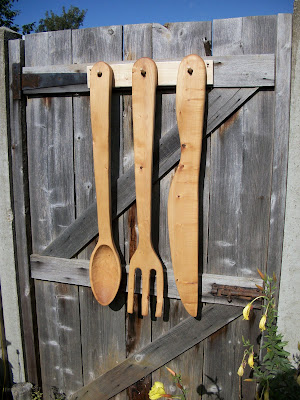It has come to my attention that there are people turning on pole lathes who have not discovered the benefits of having a spindle gouge amongst their lathe tools or how to sharpen one correctly (no names or pack drill).
In spindle work - where the grain of the wood is parallel to the axis of the lathe bed - the spindle gouge is a valuable friend and is likely to be the tool that does most of the shaping after the initial use of the roughing out gouge. The big difference between the two types of gouge is that the roughing gouge is ground straight across by simply rotating the handle whereas the spindle gouge has a ‘fingernail’ shape when viewed from above. The fingernail shape is formed by swinging the handle about 25∘from side to side at the same time as rotating it against the stone. This isn’t an easy thing to do and it does take a bit of practise to get right. There are expensive jigs that you can buy or you could make your own or you can do it freehand, as I do, on a cheap dry grinder. If you’re using a dry grinder for prolonged periods make sure to dip the tool regularly in cold water so you don’t burn the edge.
There is a lot of controversy surrounding woodturning tools and sharpening angles etc. Some authorities say that the correct grinding angle for a spindle gouge is 30∘others say 35∘- I had a look at my own and and they are almost 45∘. My advice is to experiment and use whatever works for you and that you feel comfortable with.
I present the gouge to the stationary wheel, on the rest and flat on its back with the flute facing up.
Then I look from the side to check that the whole bevel surface is in contact with the wheel. You could colour in the bevel with a felt pen to show the point of contact.
Then switch on the grinder and as you start to rotate the tool anti-clockwise, swing the handle gradually to the left till the flute is vertical on its left edge.
Then rotate the handle clockwise as you swing it back to the flute horizontal position and keep going, swinging the handle to the right until the flute is vertical on its right edge.
It’s important to keep it in the same position on the stone - don’t let it ride up or down or you’ll end up with a multifaceted bevel - I keep my index finger in the same place on the back of the tool and use it as a stop against the rest. It’s also important not to swing the handle more than the 25∘or you will end up with a pointed profile. Keep grinding until you can feel a burr on the inside of the flute, have one bevel and a nice fingernail shape.
Life’s too short to bother honing your lathe gouges or removing the burr - use them straight off the grindstone.
You could also try putting “sharpening spindle gouges” into YouTube and see what comes up. Also for beginners I recommend Keith Rowley’s classic book “Woodturning - A Foundation Course” - he even mentions bodgers and although the book is aimed at power lathe turners the principles involved all hold good for pole lathe turning as well.
*O*




























































